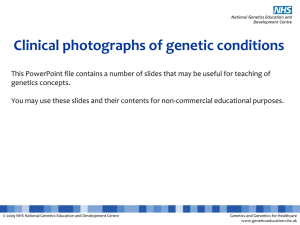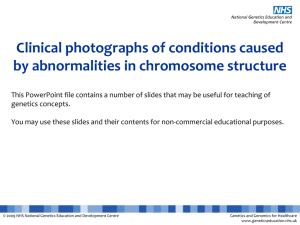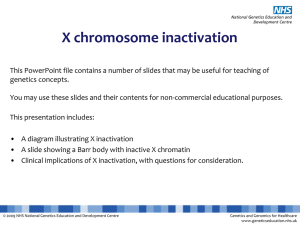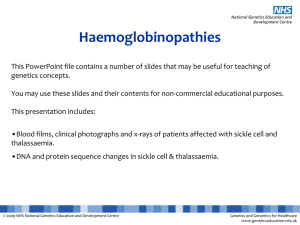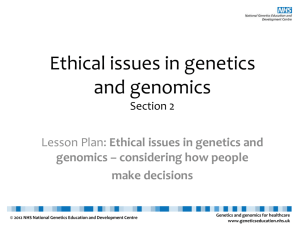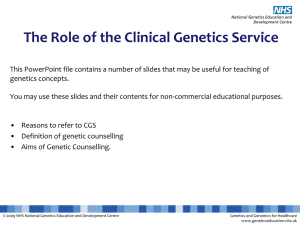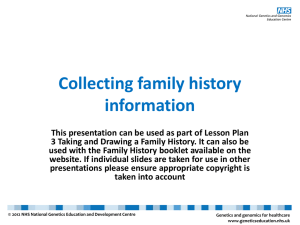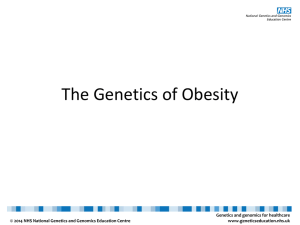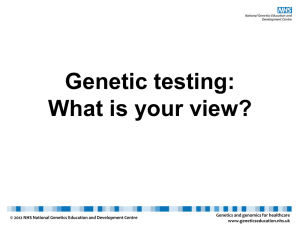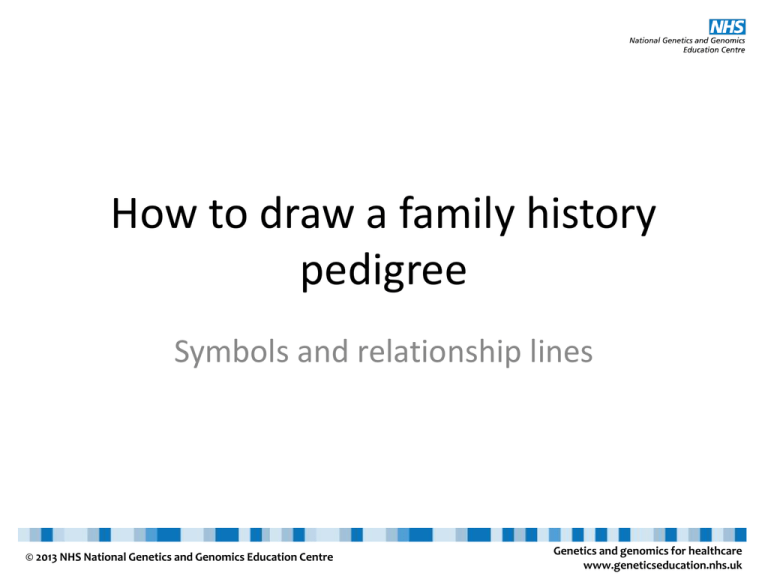
How to draw a family history
pedigree
Symbols and relationship lines
© 2013 NHS National Genetics and Genomics Education Centre
Genetics and genomics for healthcare
www.geneticseducation.nhs.uk
Drawing a family history pedigree
Taking a genetic family history is important in assisting the diagnosis of a condition in a
family.
The family history is usually recorded as a ‘family tree’ using symbols and lines.
These standardised symbols and lines have been adopted internationally. This ensures
that health professionals throughout the world can understand and interpret family
history information.
Each of the symbols represent either an individual or an event in a family. They then
need to be connected together to show the relationships in a family. We do this using
lines. Drawing lines between pedigree symbols correctly is the sign of a good family
history pedigree.
© 2013 NHS National Genetics and Genomics Education Centre
Genetics and genomics for healthcare
www.geneticseducation.nhs.uk
Symbols
A square represents a male
A circle represents a female
A diamond is entered if the sex of a family member is unknown
If an individual is affected by a condition, the symbol is coloured in
5
A number in a symbol represents multiple individuals
© 2013 NHS National Genetics and Genomics Education Centre
Genetics and genomics for healthcare
www.geneticseducation.nhs.uk
Symbols
If a member of the family is deceased, a line is drawn through the symbol
The letter ‘P’ inside a symbol represents a pregnancy
P
Male
Female
A miscarriage is represented by a triangle with the sex
written underneath. If the sex is unknown then this is left
blank.
An arrow indicates the person providing the family history
information
© 2013 NHS National Genetics and Genomics Education Centre
Genetics and genomics for healthcare
www.geneticseducation.nhs.uk
Lines
There are four different types of lines used when drawing a pedigree. The first is
called a relationship line and is a horizontal line between two people.
To indicate a marriage, a horizontal line is drawn between the
male and female symbols.
To show a divorce or separation, two downward lines are made
from top right to bottom left over the marriage line.
To indicate a marriage between blood relatives (consanguineous
relationship), two marriage lines are drawn horizontally between
the male and female symbols.
© 2013 NHS National Genetics and Genomics Education Centre
Genetics and genomics for healthcare
www.geneticseducation.nhs.uk
Lines
After the relationship line, a vertical line is drawn from parents to children and is called
a ‘line of descent’.
The ‘sibship line’ is a horizontal line joining brothers and sisters.
Each person has an ‘individual line’ which is a vertical line drawn down from the
sibship line.
Relationship line
Line of descent
Sibship line
Individual line
P
© 2013 NHS National Genetics and Genomics Education Centre
Genetics and genomics for healthcare
www.geneticseducation.nhs.uk
To access other resources for teaching and
learning genetics, please visit:
www.geneticseducation.nhs.uk
© 2013 NHS National Genetics and Genomics Education Centre
Genetics and genomics for healthcare
www.geneticseducation.nhs.uk


